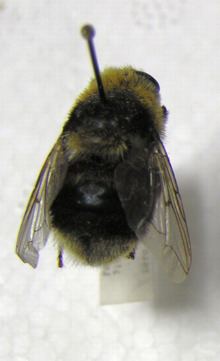Order Diptera Family Oestridae Scientific name Cephenemyia ulrichii Rank Species | Superfamily Oestroidea Subfamily Oestrinae Higher classification Cephenemyia | |
 | ||
Similar Cephenemyia, Botfly, Insect, Brachycera, Fly | ||
Cephenemyia ulrichii or the moose botfly, sometimes also called an elk botfly or moose nose botfly or moose throat botfly, is a large botfly that resembles a bumblebee. In the wild, they attack chiefly the nostrils and pharyngeal cavity of moose (known as elk in Europe), but have been found in deer. There have also been several cases of C. ulrichii squirting their larvae into the eyes of human beings, a somewhat painful event that requires medical attention to forestall any possibility of serious damage.
Contents
Description
The adult C. ulrichii botfly is 16–18 mm long, its body covered with fluffy hairs of yellow, black, and white, making it look like a bumblebee. Mouth parts are reduced, and like other adult Cephenemyia they do not feed.
Eggs hatch inside the female into first instar larvae, which are minute, white with black heads, and barbed. In sunny weather, from July to September, females seek out an appropriate host site, typically nostrils of a moose, and forcefully eject larvae onto its surface. Larvae enter their second instar in the moose's nostrils, then travel to its throat for the third instar. Third instar larvae have rows of spines on both ventral and dorsal surfaces and may be up to 4 cm long.
When fully formed, the larva is ejected by the moose, mixed with blood and mucus. It pupates in the soil.
Habitat
C. ulrichii are common parasites of moose in northeastern parts of Scandinavia, but have recently expanded their range into southern Sweden. They have also been reported in Denmark, northeast Norway, and the Baltic states.
Although once thought to be very species specific to Alces alces, they have recently been found in roe deer (Capreolus capreolus) near Helsinki.
Economic and medical impact
Several cases of human ophthalmomyiasis due to C. ulrichii have been reported in Sweden and Finland. In one case in 2010, a woman was walking in the woods near Falun in Dalarna, Sweden, when an elk botfly squirted more than 30 larvae into her eye. The larvae were removed by a doctor before they attached to the cornea, which can cause serious damage. Due to their barbs, it is difficult to wash the larvae out of the eye. One physician has suggested that C. ulrichii mistakes a human eye for the nostril of an elk because human eyes face forward, as do elk nostrils.
Botfly larvae of other kinds have also been known to cause eye problems for human beings.
